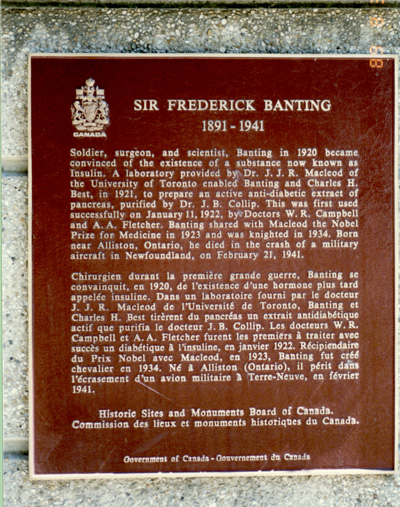Banting, Sir Frederick G. National Historic Person
Toronto, Ontario

Plaque in Toronto
© Parks Canada | Parcs Canada
Address :
112 College Street, Toronto, Ontario
Recognition Statute:
Historic Sites and Monuments Act (R.S.C., 1985, c. H-4)
Designation Date:
1945-05-16
Life Date:
1891 to 1941
Other Name(s):
-
Banting, Sir Frederick G.
(Designation Name)
Research Report Number:
2008-042
Importance:
Co-discoverer of insulin, shared Nobel Prize for medicine in 1923
Plaque(s)
Existing plaque: 5116 Sir Frederick Banting Road, Alliston, Ontario
Soldier, surgeon, and scientist, Banting in 1920 became convinced of the existence of a hormone known as insulin. A laboratory provided by Prof. J. J. R. Macleod of the University of Toronto enabled Banting and Charles H. Best, in 1921, to prepare an active anti-diabetic extract of pancreas, purified by Prof. J. B. Collip. This substance was first used successfully on a patient on January 23, 1922, by Drs. W. R. Campbell and A. A. Fletcher. Banting received the Nobel Prize for Medicine with Macleod in 1923 and was knighted in 1934. Born in Alliston, he died in the crash of a military aircraft in Newfoundland, on February 21, 1941.
Existing plaque: 112 College Street, Toronto, Ontario
Soldier, surgeon, and scientist, Banting in 1920 became convinced of the existence of a substance now known as Insulin. A laboratory provided by Dr. J. J. R. Macleod of the University of Toronto enabled Banting and Charles H. Best, in 1921, to prepare an active anti-diabetic extract of pancreas, purified by Dr. J. B. Collip. This was first used successfully on January 11, 1922, by Doctors W. H. Campbell and A. A. Fletcher. Banting shared with Macleod the Nobel Prize for Medecine in 1923 and was knighted in 1934. Born near Alliston, Ontario, he died in the crash of a military aircraft in Newfoundland, on February 21, 1941.